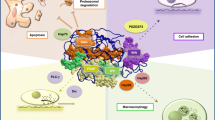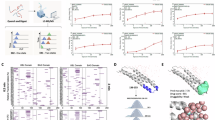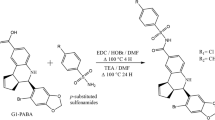Abstract
Aim:
BAG-1 is a multifunctional anti-apoptotic gene with four isoforms, and different BAG-1 isoforms have different anti-apoptotic functions. In this study, we transfected BAG-1 isoforms into the human breast cancer cell lines Hs578T (ER negative) and MCF-7 (ER positive) to study their effect on apoptosis with or without estrogens.
Methods:
The constructed recombinant expression vectors carrying individual BAG-1 isoforms was used to transfect human breast cancer cell lines Hs578T (ER negative) and MCF-7 (ER positive). After stable cell lines were made, a variety of apoptosis-inducing agents, including doxorubicin, docetaxel, and 5-FU, was used to treat these cell lines with or without estrogen to test the role of BAG-1. The mechanism by which BAG-1 affected the function of Bcl-2 was exploredby using the cycloheximide chase assay.
Results:
The BAG-1 p50 and p46 isoforms significantly enhanced the resistance to apoptosis in both cell lines according to flow cytometry analysis. BAG-1 p33 and p29 failed to protect the transfected cells from apoptosis. The cell viability assay showed that only BAG-1 p50, but not p46, p33, or p29, increased estrogen-dependent function in ER-positive cell line MCF-7. Only BAG-1 p50 dramatically increased its anti-apoptotic ability in the presence of estrogen, while estrogen has very little effect on the anti-apoptotic ability of other BAG-1 isoforms. In the detection of the expression of K-ras, Hsp70, cytochrome c, Raf-1, ER-α, and Bcl-2 in MCF-7 cells by Western blot, only Bcl-2 protein expression was significantly increased in MCF-7 cells transfected with BAG-1 p50 and p46, respectively. Furthermore, the cycloheximide chase assay indicated that the degradation of Bcl-2 protein was extended in the BAG-1 p50 and p46 transfected MCF-7 cells.
Conclusion:
Distinct isoforms of BAG-1 have different anti-apoptotic functions in breast cancer cells, and that the BAG-1 p50 isoform can potentiate the role of estrogen in ER-positive breast cancer.
Similar content being viewed by others
Log in or create a free account to read this content
Gain free access to this article, as well as selected content from this journal and more on nature.com
or
References
Takayama S, Sato T, Krajewski S, Kochel K, Irie S, Millan JA, et al. Cloning and functional analysis of BAG-1: a novel Bcl-2-binding protein with anti-cell death activity. Cell 1995; 80: 279–84.
Wang HG, Takayama S, Rapp UR, Reed JC . Bcl-2 interacting protein, BAG-1, binds to and activates the kinase Raf-1. Proc Natl Acad Sci USA 1996; 93: 7063–8.
Chen J, Xiong J, Liu H, Chernenko G, Tang SC . Distinct BAG-1 isoforms have different anti-apoptotic functions in BAG-1-trans fected C33A human cervical carcinoma cell line. Oncogene 2002; 21: 7050–9.
Xiong J, Chen J, Chernenko G, Beck J, Liu H, Pater A, et al. Antisense BAG-1 sensitizes HeLa cells to apoptosis by multiple pathways. Biochem Biophys Res Commun 2003; 312: 585–91.
Tang SC, Beck J, Murphy S, Chernenko G, Robb D, Watson P, et al. BAG-1 expression correlates with Bcl-2, p53, differentiation, estrogen and progesterone receptors in invasive breast carcinoma. Breast Cancer Res Treat 2004; 84: 203–13.
Cutress RI, Townsend PA, Sharp A, Maison A, Wood L, Lee R, et al. The nuclear BAG-1 isoform, BAG-1L, enhances oestrogen-dependent transcription. Oncogene 2003; 22: 4973–82.
Yang X, Chernenko G, Hao Y, Ding Z, Pater MM, Pater A, et al. Human BAG-1/RAP46 protein is generated as four isoforms by alternative translation initiation and overexpressed in cancer cells. Oncogene 1998; 17: 981–9.
Cato AC, Mink S . BAG-1 family of cochaperones in the modulation of nuclear receptor action. J Steroid Biochem Mol Biol 2001; 78: 379–88.
Bardelli A, Longati P, Albero D, Goruppi S, Schneider C, Ponzetto C, et al. HGF receptor associates with the anti-apoptotic protein BAG-1 and prevents cell death. Embo J 1996; 15: 6205–12.
Clevenger CV, Thickman K, Ngo W, Chang WP, Takayama S, Reed JC . Role of Bag-1 in the survival and proliferation of the cytokine-dependent lymphocyte lines, Ba/F3 and Nb2. Mol Endocrinol 1997; 11: 608–18.
Luders J, Demand J, Papp O, Hohfeld J . Distinct isoforms of the cofactor BAG-1 differentially affect Hsc70 chaperone function. J Biol Chem 2000; 275: 14817–23.
Niyaz Y, Zeiner M, Gehring U . Transcriptional activation by the human Hsp70-associating protein Hap50. J Cell Sci 2001; 114 (Pt 10): 1839–45.
Zeiner M, Niyaz Y, Gehring U . The hsp70-associating protein Hap46 binds to DNA and stimulates transcription. Proc Natl Acad Sci USA 1999; 96: 10194–9.
Sondermann H, Scheufler C, Schneider C, Hohfeld J, Hartl FU, Moarefi I . Structure of a Bag/Hsc70 complex: convergent functional evolution of Hsp70 nucleotide exchange factors. Science 2001; 291: 1553–7.
Takayama S, Bimston DN, Matsuzawa S, Freeman BC, Aime-Sempe C, Xie Z, et al. BAG-1 modulates the chaperone activity of Hsp70/Hsc70. EMBO J 1997; 16: 4887–96.
Takayama S, Xie Z, Reed JC . An evolutionarily conserved family of Hsp70/Hsc70 molecular chaperone regulators. J Biol Chem 1999; 274: 781–6.
Antoku K, Maser RS, Scully WJ Jr, Delach SM, Johnson DE . Isolation of Bcl-2 binding proteins that exhibit homology with BAG-1 and suppressor of death domains protein. Biochem Biophys Res Commun 2001; 286: 1003–10.
Froesch BA, Takayama S, Reed JC . BAG-1L protein enhances androgen receptor function. J Biol Chem 1998; 273: 11660–6.
Kullmann M, Schneikert J, Moll J, Heck S, Zeiner M, Gehring U, et al. RAP46 is a negative regulator of glucocorticoid receptor action and hormone-induced apoptosis. J Biol Chem 1998; 273: 14620–5.
Zeiner M, Gebauer M, Gehring U . Mammalian protein RAP46: an interaction partner and modulator of 70 kDa heat shock proteins. EMBO J 1997; 16: 5483–90.
Takahashi N, Sasaki R, Takahashi J, Takayama S, Reed JC, Andoh T . BAG-1M, an isoform of Bcl-2-interacting protein BAG-1, enhances gene expression driven by CMV promoter. Biochem Biophys Res Commun 2001; 286: 807–14.
Luders J, Demand J, Hohfeld J . The ubiquitin-related BAG-1 provides a link between the molecular chaperones Hsc70/Hsp70 and the proteasome. J Biol Chem 2000; 275: 4613–7.
Acknowledgements
This work was supported by grants from the National Natural Science Foundation of China (No 30500221 to Jun CHEN; No 30500496 to Hong-yu LIU). We also acknowledge the National Key Technology Research and Development Program of China (No 2006BAI02A00, Qing-hua ZHOU).
Author information
Authors and Affiliations
Corresponding authors
Rights and permissions
About this article
Cite this article
Liu, Hy., Wang, Zm., Bai, Y. et al. Different BAG-1 isoforms have distinct functions in modulating chemotherapeutic-induced apoptosis in breast cancer cells. Acta Pharmacol Sin 30, 235–241 (2009). https://doi.org/10.1038/aps.2008.21
Received:
Accepted:
Published:
Issue date:
DOI: https://doi.org/10.1038/aps.2008.21



